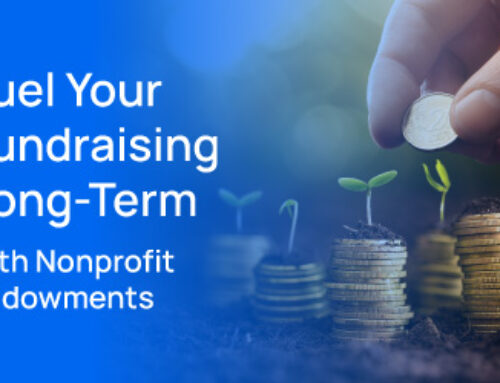
If your fundraising event or the end of a specific fundraising campaign is quickly approaching and you haven’t quite hit your goal, try not to stress. While it is frustrating and even demoralizing to be shy of your fundraising goal at the eleventh hour, there’s a powerful strategy you can employ at the last minute to boost revenue: peer-to-peer fundraising.
In peer-to-peer fundraising, nonprofits essentially ask their volunteers and supporters to reach out to their individual networks to raise money on their behalf. Peer-to-peer fundraising often leverages social media and tech platforms to share campaigns, collect payments, and track progress.
So whether you’re hosting a charity golf tournament and haven’t hit your target numbers or are running a donation campaign that’s short of its objective, you can tap into the power of peer-to-peer fundraising with these four strategies to beat the clock and meet your goals.
1. Lean Into Storytelling
Your nonprofit’s story is an invaluable tool when it comes to fundraising. It’s even more important when empowering your supporters to raise money from their peers. They need to be able to share a compelling reason to get others to act and make a donation. This can be referred to as social proof, or the idea that if people who trust you see you publicly supporting a cause, they’ll be more motivated to follow your lead. According to Double the Donation, younger donors in particular are more likely to donate to a cause if they see their friends and family supporting it.
You can further amplify the impact of social proof by creating custom materials, graphics, and messaging for your fundraisers. For instance, if a company is hosting a corporate golf tournament to benefit your nonprofit, create social media graphics and messaging for golfers to share to encourage others to register to play in or sponsor the event or simply make a donation to the cause. Or if your nonprofit is asking beneficiaries to help drive donations for a capital campaign, provide “share my story” templates that help them tell about their experience with your nonprofit and why others should make a donation. These materials should be easily shareable across multiple channels—email, social media, direct mail, and SMS—so your fundraiser can easily reach as many of their peers as possible.
2. Create Urgency With Limited Time Challenges
Creating urgency within your peer-to-peer campaigns motivates people to give, and give now. Stressing this urgency and the importance of your cause activates fundraisers and is a great way to get people to donate quickly. What’s more, time-sensitive challenges can bring out a competitive spirit in your supporters to reach more people to raise more money. For example, if you’re 24 hours away from an event or the end of a campaign, provide an incentive to the fundraiser who raises the most money in that period of time, like branded merchandise or a gift card to their favorite coffee shop. Or if you’re one week out from your gala or charity auction, you might push attendees to get three or four people to register before the deadline or to donate an auction item. These types of time-based challenges can push your fundraising goal past the finish line and get people excited about your cause.
3. Use Digital Platforms to Run Campaigns
Digital platforms make collecting donations quick and easy, both for your organization and your donors. Everything is automated, which takes your time out of the equation—you get to reap the rewards without having to manually deal with payments and receipts. Online platforms can also make it simpler for your supporters to share campaigns with their networks and track the campaign’s progress toward its ultimate goal. Here are a few tools and platforms to explore:
- Social media. Social media companies, like Meta, have built-in features for nonprofits to collect donations. For instance, fundraisers conducted via Facebook Challenges lead users to a custom donation page on an individual fundraiser’s profile. This makes the donation process more convenient for donors, since they don’t even have to close the app to make a contribution. You’ll need to configure your social media fundraising tools, then and ask your peer-to-peer fundraisers to direct their followers to your page.
- QR codes. Smartphones have built-in QR code scanners, making it easy for the majority of people to instantly access your donation site. Create a QR code and attach it to your eleventh-hour outreach materials, such as your blitzes on social media and SMS.”
- Event management software. There are dedicated peer-to-peer platforms you can use, but you can also leverage the payment processing capabilities of your event management software to keep all payments for a specific event or corresponding campaign in one place.
4. Host a Last-Minute Matching Gift Push
 Matching gifts help amplify fundraising exponentially and work especially well for peer-to-peer efforts. A matching gift acts as a form of social proof to instantly multiply impact. How? When a prospective donor sees that their gift will be matched, either by a large donor, sponsor, or grassroots supporter, they’re more likely to act.
Matching gifts help amplify fundraising exponentially and work especially well for peer-to-peer efforts. A matching gift acts as a form of social proof to instantly multiply impact. How? When a prospective donor sees that their gift will be matched, either by a large donor, sponsor, or grassroots supporter, they’re more likely to act.
Before you launch the last-minute campaign, reach out to your fundraisers to describe how the gift matching push will work. We suggest this standard formula: If your nonprofit is still short of your fundraising goal at a specified date or time, your fundraiser will send a new call to action or message to their networks announcing and promoting the matching gift opportunity.
Of course, if you’re relying on a matching donor, you’ll want to secure them ahead of time and determine the terms and threshold of the match. You might also encourage your peer fundraisers to match gifts from their own pockets (if they’re financially able). Pairing these two options can be especially powerful, as it provides two matching opportunities that can persuade more people to contribute.
The Bottom Line
While peer-to-peer fundraising is certainly powerful, there’s a fine line between motivating and burning out your peer fundraisers. Ensure you’re not pushing too hard or asking too much of these loyal supporters so they’re turned off from returning for future peer-to-peer campaigns. It’s also important to find ways to thank them, whether it’s shoutouts on social media to top fundraisers, a thank you phone call or handwritten note from your board chair, or sending them a branded coffee mug. Effectively engaging, empowering, and thanking your peer fundraisers can push your fundraising events and campaigns past your goal.
About the Author

Logan Foote has been around the game of golf nearly his entire life. He first picked up a club at the age of four, and despite thousands of attempts, he’s never had a hole-in-one. He earned a bachelor’s degree in business administration at the University of Nebraska-Lincoln and pursued a career in sales. Logan came to GolfStatus in 2017, where he channels his passion for golf to help nonprofits raise money through the game. As Sales and Education Manager, Logan oversees a team that works with thousands of nonprofit clients to maximize their golf fundraisers with the GolfStatus platform, and shares his golf fundraising expertise through GolfStatus’s free educational webinars. He lives and golfs in Lincoln, Nebraska with his wife and three sons.





